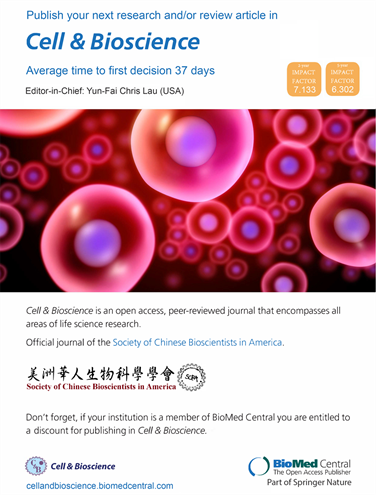抑制 HSPA8 可通过 SKP2 减缓 NLRP3 泛素化,从而促进脓毒症诱发的肺损伤中的脓毒症
IF 6.1
2区 生物学
Q1 BIOCHEMISTRY & MOLECULAR BIOLOGY
引用次数: 0
摘要
急性肺损伤(ALI)与脓毒症患者的住院时间和死亡率密切相关。最近的证据表明,由 NLRP3(含 NOD、LRR 和 pyrin 结构域的 3)炎性体激活介导的热变态反应在脓毒症中起着关键作用。在本研究中,我们证明了在脂多糖(LPS)和三磷酸腺苷(ATP)处理的小鼠肺泡上皮细胞(AECs)中,NLRP3 炎性体通过下调热休克蛋白家族 A 成员 8(HSPA8)而被激活。在盲肠结扎和穿刺(CLP)小鼠中,香叶基丙酮(GGA)诱导的HSPA8过表达可显著降低全身炎症反应和死亡率,有效保护肺功能,而HSPA8抑制剂VER155008则会加重这种效应。HSPA8抑制剂通过促进AECs的脓毒症急性肺损伤。HSPA8 的下调激活了 NLRP3 炎症小体,通过促进 E3 泛素连接酶 S 期激酶相关蛋白 2(SKP2)的降解来介导脓毒症。此外,当受到 LPS 和 ATP 的刺激时,下调的 SKP2 会通过进一步减少 NLRP3 的泛素化来促进 AECs 的热解。腺相关病毒9-SKP2(AAV9-SKP2)可促进NLRP3泛素化和降解,减轻肺损伤并抑制体内全身炎症反应。总之,我们的研究表明,有强有力的统计学证据表明,HSPA8的抑制通过促进E3泛素连接酶SKP2的降解,进而减弱NLRP3的泛素化,激活NLRP3炎性体,从而介导肺泡上皮细胞的脓毒症,这为治疗脓毒症引起的肺损伤提供了一个新的视角和治疗靶点。本文章由计算机程序翻译,如有差异,请以英文原文为准。
The suppression of HSPA8 attenuates NLRP3 ubiquitination through SKP2 to promote pyroptosis in sepsis-induced lung injury
Acute lung injury (ALI) is strongly associated with hospitalization and mortality in patients with sepsis. Recent evidence suggests that pyroptosis mediated by NLRP3(NOD-, LRR- and pyrin domain-containing 3) inflammasome activation plays a key role in sepsis. However, the mechanism of NLRP3 inflammasome activation in sepsis-induced lung injury remains unclear. in this study, we demonstrated that NLRP3 inflammasome was activated by the down-regulation of heat shock protein family A member 8 (HSPA8) in Lipopolysaccharide (LPS) and adenosine triphosphate (ATP)-treated mouse alveolar epithelial cells (AECs). Geranylgeranylacetone (GGA)-induced HSPA8 overexpression in cecum ligation and puncture (CLP) mice could significantly reduce systemic inflammatory response and mortality, effectively protect lung function, whilst HSPA8 inhibitor VER155008 aggravated this effect. The inhibition of HSPA8 was involved in sepsis induced acute lung injury by promoting pyroptosis of AECs. The down-regulation of HSPA8 activated NLRP3 inflammasome to mediate pyroptosis by promoting the degradation of E3 ubiquitin ligase S-phase kinase-associated protein 2 (SKP2). In addition, when stimulated by LPS and ATP, down-regulated SKP2 promoted pyroptosis of AECs by further attenuating ubiquitination of NLRP3. Adeno-associated virus 9-SKP2(AAV9-SKP2) could promote NLRP3 ubiquitination and degradation, alleviate lung injury and inhibit systemic inflammatory response in vivo. in summary, our study shows there is strong statistical evidence that the suppression of HSPA8 mediates alveolar epithelial pyroptosis by promoting the degradation of E3 ubiquitin ligase SKP2 and subsequently attenuating the ubiquitination of NLRP3 to activate the NLRP3 inflammasome, which provides a new perspective and therapeutic target for the treatment of sepsis-induced lung injury.
求助全文
通过发布文献求助,成功后即可免费获取论文全文。
去求助
来源期刊

Cell and Bioscience
BIOCHEMISTRY & MOLECULAR BIOLOGY-
CiteScore
10.70
自引率
0.00%
发文量
187
审稿时长
>12 weeks
期刊介绍:
Cell and Bioscience, the official journal of the Society of Chinese Bioscientists in America, is an open access, peer-reviewed journal that encompasses all areas of life science research.
 求助内容:
求助内容: 应助结果提醒方式:
应助结果提醒方式:


